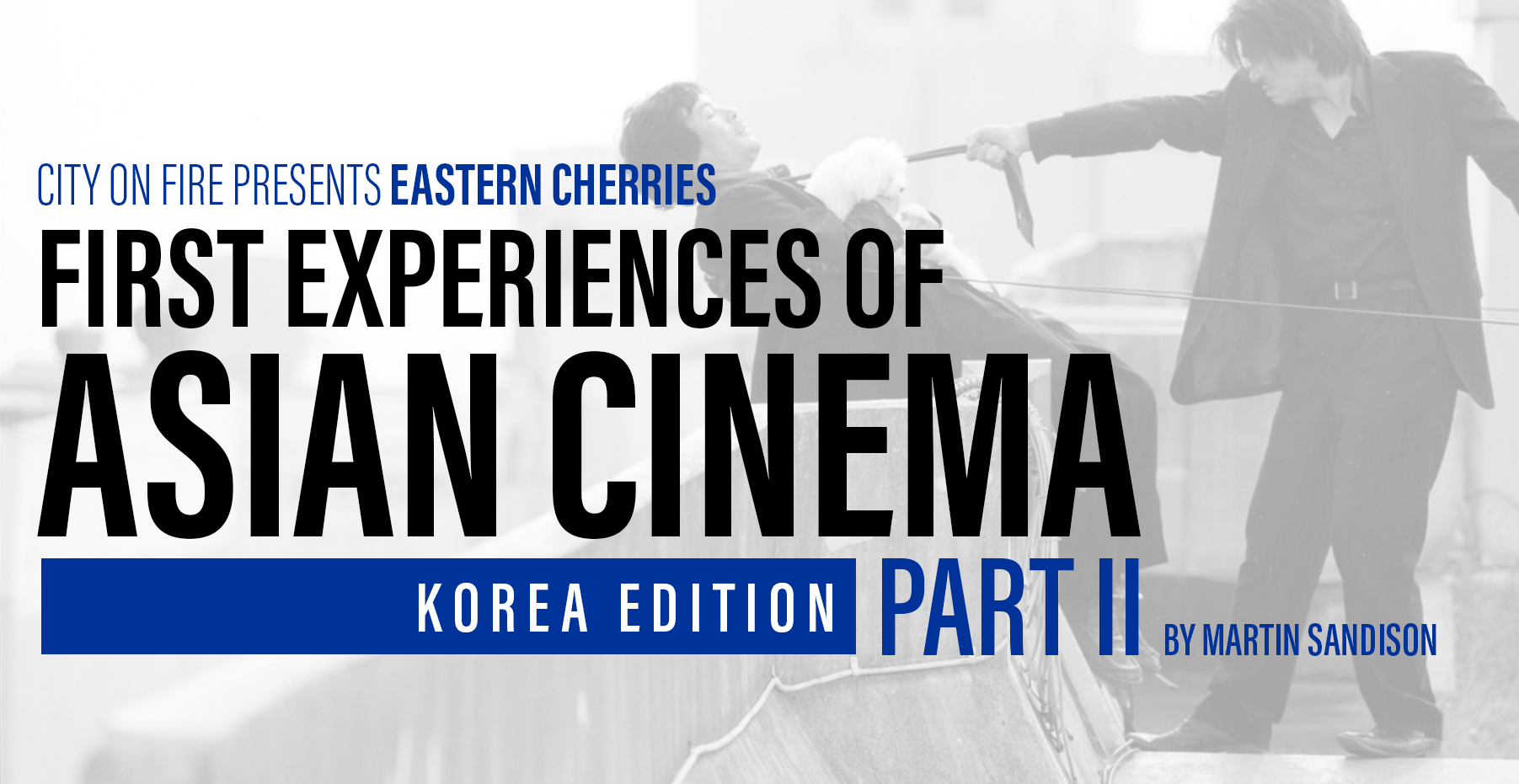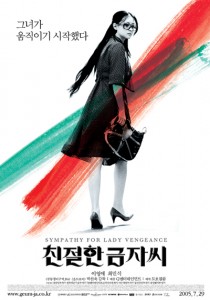 As a young kid of 18, I used to watch a British Television film review programme, then presented by Johnathan Ross. A major advocate of Eastern cinema, Ross is a larger than life character with an abundance of knowledge of especially Asian action movies. At the end of one programme there was a clip of the South Korean film Nowhere to Hide, featuring two characters fighting in the pouring rain, with a magnetic aesthetic and wholly different style than I had experienced before. I sat up, and took notice. This was my first exposure to South Korean cinema.
As a young kid of 18, I used to watch a British Television film review programme, then presented by Johnathan Ross. A major advocate of Eastern cinema, Ross is a larger than life character with an abundance of knowledge of especially Asian action movies. At the end of one programme there was a clip of the South Korean film Nowhere to Hide, featuring two characters fighting in the pouring rain, with a magnetic aesthetic and wholly different style than I had experienced before. I sat up, and took notice. This was my first exposure to South Korean cinema.
From then, come my early 20’s, I caught Sympathy for Mr. Vengeance. I had read some about the movie, and it seemed interesting, so I checked it out. While a little impenetrable, the style and atmospheric approach made an impression on me, as well as the unusual narrative. Come Edinburgh Film Festival in 2004, I heard that the second film in the trilogy was to be screened, with director Park Chan-Wook in attendance. For some silly reason I didn’t attend, and regret it to this day, as the film was Oldboy. About half a year later I settled down to watch the film on DVD, and by this point the buzz and great reviews for the film had reached fever pitch. I was completely knocked out, to the extent that it has maintained a place in my top ten ever since, and whenever I revisit the film it retains power and nuance to the point that I love it more every time.
The legacy of Oldboy is plain to see, with the explosion of Korean cinema coming in its wake, and making Park Chan-Wook one of the most recognisable directors on the international film scene. What struck me about the film most is its constant visual inventiveness; at the time I was soaking up classic Hong Kong cinema, which for me is the greatest in these terms ever made. Of course the Korean new wave’s biggest influence was this cinema, and it is reflected but refracted through the Korean gaze, nowhere more evident than in Oldboy. Every shot in the film has a surreal, beautifully strange quality and creates an all-encompassing world, one that involves a more dream-like and operatic but low key feel than a lot of Hong Kong cinema.
Two other aspects stand out for me too: Choi Min Sik’s performance and, of course, that fight scene. I had never seen a fight so raw, brutal and relentless. I would wager that Park was very influenced by the fights in the Hong Kong Heroic Bloodshed genre, with their realism and unnerving violence, but Oldboy took this to another level – so spellbinding is that sequence! Choi’s commitment to the film and his characters suffering (of which there is a lot) is so impactful and thought provoking that it rates as one of the finest in the history of cinema. I caught the new documentary about the film Old Days, and was taken in by Choi’s openness and candid conversation when discussing making the film and how hard it was, especially the fight scene of course. Supposed to be an extra on the forthcoming Blu-ray release, the documentary is now a stand alone film. Any fan of Oldboy should check it out.

Oldboy is the kind of film that has made such an impact on the public consciousness that a lot of people have seen, or at least know of, the film. For me, like Project A and Sword of Doom, it opened up a nations cinema that has consistently since Oldboy’s release produced many classics of the modern age, to the point that arguably (and in my mind definitely) they are the best in international cinema. Parks last in the Trilogy, Lady Vengeance, while a step down is still a disturbing and vital film. Even lesser Chan-Wook films such as Thirst blew me away.
The next Korean film I saw in the cinema was Kim Jee-Woon’s A Bittersweet Life, which breathed new life in to the Asian gangster film, and remains quintessential. His I Saw the Devil is my 2nd favourite South Korean film. The best of this nations cinema create new narratives and moral compasses from old genre tropes, and the two films that are greatest at this for me are Oldboy and I Saw the Devil. Both use the revenge story and twist the themes and characterisations to create a modern, complex palette of conflicting morality, one that is without the centralised and predictable way of Hollywood films of the last so many years. In a South Korean film it is difficult to predict what will happen, and which character and narrative resolution there will be, something which went out in Hollywood, with some exceptions, come the 1980’s.
That this renaissance in South Korean film, began by Oldboy, is still going strong some 15 years later is remarkable. New classics such as The Wailing and The Handmaiden prove the breath of fresh air created by that early Noughties surge is alive and kicking. In fact I recently watched Lee Chang-Dong’s Green Fish, which predates Oldboy by some 6 years and is one of the first Korean Noir films, and was struck by its originality and relevance even now. It took me till about 2008 to finally catch Nowhere to Hide, and its new style of action and stylistic power impressed me. This of course led to my love of Korean action cinema, such as the films of Ryoo Seung-Wan (Veteran, City of Violence, The Berlin File), and an admiration for their choreographal style which is influenced by, but very different from, classic Hong Kong stuff. Even a movie as dark and disturbing as I Saw the Devil leaves room for brilliantly staged fights, a combination which I fucking adore.
As South Korean cinema maintains its lofty position, it will be interesting to see what occurs in the coming years; that’s almost two decades in which there have been many classics, but whether any can match the pure adrenalin shot of Oldboy remains to be seen.
Read First Experiences of Asian Cinema: Korea Edition Part I
Read First Experiences of Asian Cinema: Korea Edition Part III
Read First Experiences of Asian Cinema: Korea Edition Part IV






Great feature Martin! Ok, I’m going to get controversial 😛 –
“I was soaking up classic Hong Kong cinema, which for me is the greatest in these terms ever made. Of course the Korean new wave’s biggest influence was this cinema”
I’d actually argue the reason the Korean new wave became the success it is, was because Korean cinema stopped copying the Hong Kong aesthetic. Watch any Korean gangster/thriller/action flick from the 1985 – 1995 era, and the stamp of the Hong Kong classics is clear to see. It was movies like ‘Nowhere to Hide’ and ‘Oldboy’ that allowed Korean cinema to find its voice, largely due to the significant amount of funding that was poured into the arts in the late 90’s/early 00’s.
“Parks last in the Trilogy, Lady Vengeance, while a step down is still a disturbing and vital film.”
It’s funny, I used to feel the same way, but over the years I’ve come to rank ‘Lady Vengeance’ as the better movie over ‘Oldboy’. But either way, you still get a dose of Choi Min-sik with both movies! 🙂
PS Don’t think I didn’t notice how you snuck in a reference to a film festival!
What can I say, my first Korean film was Bruce Lee Fights Back From The Grave!
To be honest I think we were all expecting Martin’s entry to be a Dragon Lee flick. 😛
Cheers Paul! Ha ha the first Dragon Lee flick I saw was The Dragon, The Hero, still a psychedelic classic! My knowledge of earlier 90s South Korean cinema ain’t the best, oh teach me sifu Bramhall! I haven’t watched Lady Vengeance in a while, time to reacess…
Man, I wish I could, but releases of them on DVD (let along English subtitled or on Blu-ray!) are few and far between. A pretty classic example from that period of Korean action cinema though is ‘Ggok-Ji-Ddan’ from 1990, check out this clip and tell me you’re not feeling the HK vibes! 🙂
Oh, and I’ll be going to the Udine film festival again this year, prepare yourself for constant smug references to it in my reviews 😛